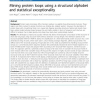Free Online Productivity Tools
i2Speak
i2Symbol
i2OCR
iTex2Img
iWeb2Print
iWeb2Shot
i2Type
iPdf2Split
iPdf2Merge
i2Bopomofo
i2Arabic
i2Style
i2Image
i2PDF
iLatex2Rtf
Sci2ools
BMCBI
2010
2010
Mining protein loops using a structural alphabet and statistical exceptionality
Background: Protein loops encompass 50% of protein residues in available three-dimensional structures. These regions are often involved in protein functions, e.g. binding site, catalytic pocket... However, the description of protein loops with conventional tools is an uneasy task. Regular secondary structures, helices and strands, have been widely studied whereas loops, because they are highly variable in terms of sequence and structure, are difficult to analyze. Due to data sparsity, long loops have rarely been systematically studied. Results: We developed a simple and accurate method that allows the description and analysis of the structures of short and long loops using structural motifs without restriction on loop length. This method is based on the structural alphabet HMM-SA. HMM-SA allows the simplification of a three-dimensional protein structure into a onedimensional string of states, where each state is a four-residue prototype fragment, called structural letter. The difficul...
BMCBI 2010 | Protein | Structural | Structural Words |
| Added | 08 Dec 2010 |
| Updated | 08 Dec 2010 |
| Type | Journal |
| Year | 2010 |
| Where | BMCBI |
| Authors | Leslie Regad, Juliette Martin, Grégory Nuel, Anne-Claude Camproux |
Comments (0)

